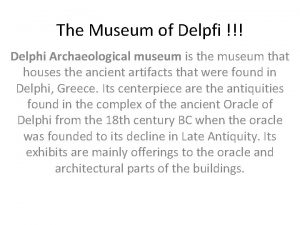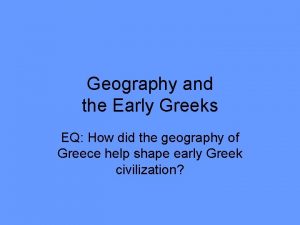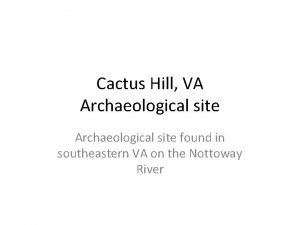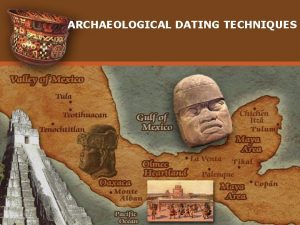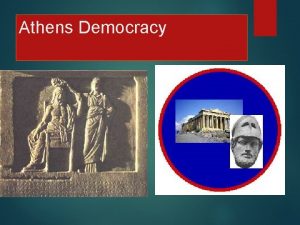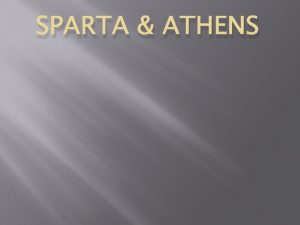A quick look at some Athens Archaeological Museum












- Slides: 12

A quick look at some Athens Archaeological Museum exhibits

Marble head of a kouros (naked youth), found at Ptoon in Boeotia. ca. 580 BC. Head of a kouros statue, made of boeotian marble. It was found in the sanctuary of Apollo on Mount Ptoon in Boeotia. The face is modeled in wide, angular levels, whereas the features are rendered in a “geometric” manner, reminiscent of wood carving. The big eyes and the long hair, arranged in beaded tresses, are common features of the early kouroi. Height 0, 33 m.

Marble statue of a kore (maiden), found at Merenda, Attica 550 -540 BC. Statue of a kore (maiden), made of Parian marble. It was found at Merenda (ancient Myrrhinous), Attica. The fully preserved statue stood on the grave of Phrasikleia, according to the inscription carved on the front of the pedestal. The kore wears a wreath on the head, jewellery (a necklace, earrings and bracelets) and a long chiton, painted red, with a variety of incised and painted motifs. It is an outstanding work, made by the sculptor Aristion from Paros, as is indicated by the inscription carved on the right side of the pedestal. Height of the statue 1, 79 m. , height with the base 2, 115 m.

Marble statue of a kouros (naked youth), found at Anavyssos, Attica ca. 530 BC. Statue of a kouros (naked youth), one of the most imposing of its kind, made of Parian marble. The funerary statue was erected on the grave of Kroisos, who fell in battle, according to the epigram carved on the front of the pedestal. Height 1, 94 m.

Bronze statue of Zeus or Poseidon, found at the bottom of the sea off cape Artemision, in north Euboea ca. 460 BC. Bronze statue of a god, found at the bottom of the sea off cape Artemision, in north Euboea. The god, shown in great stride, extends his left arm forward, while throwing the thunderbolt or the trident, which he held in his right hand. The identification as Zeus or Poseidon is controversial (the former seems more probable). The bronze statue is one of the few preserved original works of the Severe Style, notable for the exquisite rendering of motion and anatomy. It is certainly the work of a great sculptor of the early Classical period. Height 2, 09 m.

Marble statue of an athlete binding his hair (diadoumenos), found on Delos, Cyclades. Copy from about 100 BC of an original from 450 -425 BC. Statue of an athlete, made of island marble. Found in the building known as the House of the Diadoumenos, on Delos. The youth is depicted nude, binding a ribbon in his hair, a feature that suggests the identification of a victor. The piece dates from about 100 BC and is a copy of the famous statue of the “Diadoumenos” made by Polykleitos, about 450425 BC. The support in the form of a tree trunk, with the himation lying on it, is an addition by the copyist. Recent research has proved that the surface of the sculpture was gilded. Height 1, 95 m

Marble statue of a Nereid or Aura on horseback, from the temple of Asklepios at Epidauros, Peloponnese ca. 380 BC. Statue of a Nereid or Aura on horseback, made of Pentelic marble. This was the right akroterion on the west pediment of the temple of Asklepios at Epidauros, Peloponnese. The goddess is depicted riding a horse, which is rising from the Ocean. Work of the sculptor Timotheos. Height 0, 79 m.

Marble female head, possibly of Hygieia, found at Tegea, Arkadia 350 -325 BC. The youthful female head, with the wavy hair carried back, exudes divine beauty and grace. The theory, according to which it belonged to the statue of Hygieia, carved by the great sculptor Skopas, has been disputed. It is nevertheless one of the finest original works of the Late Classical period. Height 0, 285 m.

Marble theatre mask 300 -250 BC. Theatre mask made of Pentelic marble. It was found probably in Athens. Depiction of an old man, possibly the “first old man” of the New Comedy, as described by Julius Polydeuces. The high forehead is slightly bald, and the hair very short, almost shaven. The long wavy beard and moustache together frame the open mouth. The eyebrows are slightly raised, the eyes large and the cheekbones protruding. Height 0, 27 m.

Marble statue of Poseidon, from Melos, Cyclades 125 -100 BC. The statue of Poseidon, made of Parian marble, was found in 1877 on Melos, along with a statue of his mate, Amphitrite. The larger than life-size statue depicts the god almost nude, wearing a himation covering the lower part of the body. In his raised right hand he will have held the trident. Next to his right leg is a support in the form of a dolphin. Height 2, 35 m.

Marble statue of a sleeping Maenad, from Athens. Time of the emperor Hadrian (AD 117138). Statue of a sleeping Maenad, made of pentelic marble. It was found to the south of the Athenian Acropolis. The statue presumably adorned a luxury residence. The Maenad is asleep, lying on a panther skin spread on a rocky surface. The work expresses the Classicising trend of an Attic workshop. Length 1, 36 m.

Marble portrait bust of Antinoos, from Patras, Peloponnese AD 130 -138 The portrait is made of Thasian marble. The youth Antinoos of Bithynia in Asia Minor was the favorite of the emperor Hadrian. After he drowned in the river Nile in AD 130, Hadrian had him deified and erected numerous statues, busts and portraits of him in various cities and sanctuaries throughout the Roman empire. Height 0, 67 m.
 Delpfi
Delpfi Look to the left look to the right
Look to the left look to the right Archaeological site of mycenae
Archaeological site of mycenae An archaeological dig turns up large numbers
An archaeological dig turns up large numbers Cactus hill va
Cactus hill va Archaeological resources protection act of 1979
Archaeological resources protection act of 1979 Mortimer wheeler soil layer method
Mortimer wheeler soil layer method South india mountain map
South india mountain map Quick find vs quick union
Quick find vs quick union Collision forces quick check
Collision forces quick check échelle de broselow
échelle de broselow Some say the world will end in fire some say in ice
Some say the world will end in fire some say in ice Sometimes you win some
Sometimes you win some
